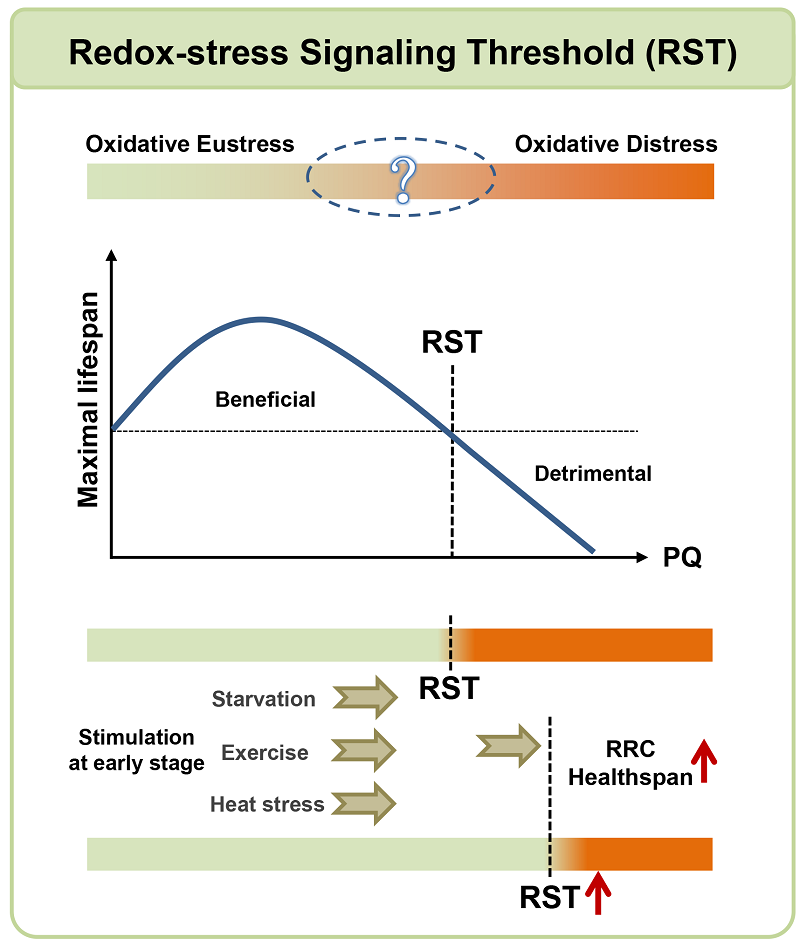Increasing Redox-stress Signaling Threshold (RST) promotes healthy aging
Reactive oxygen species (ROS) are known to play a dual role since they can be either beneficial or harmful to living systems. This dual characteristic has attracted widespread attention. The beneficial effect is defined as oxidative eustress, while the harmful effect is defined as oxidative distress. However, how to distinguish the two effects remains unclear. CHEN Chang and her group, Institute of Biophysics, Chinese Academy of Sciences, proposed and defined the concept of Redox-stress Signaling Threshold (RST) to distinguish these two effects. The threshold was quantitatively described by C. elegans model and it was found that early stimulation could increase RST to promote healthy aging of nematode. The paper titled "Identification of the Redox-Stress Signaling Threshold (RST): Increased RST helps to delay aging in C. elegans" was recently published online in Free Radical Biology and Medicine.
In order to identify and quantify the threshold at which ROS induced by stimulation changes from beneficial to harmful, the research fellows used C. elegans as a model to describe and quantify the different effects of oxidative stress induced by different concentrations of paraquat (PQ) on nematode lifespan. It was found that there is a turning point concentration of PQ below which oxidative stress can prolong lifespan, while oxidative stress above this concentration is harmful to the survival of nematodes. This study quantified and defined this threshold, named "Redox-stress Signaling Threshold (RST)". Further studies found that several different stimuli early in life, including starvation, exercise and heat stress, could improve the Redox-stress Response Capacity (RRC) by increasing the RST and thus promote healthy aging.
In the normal aging process, ROS concentrations can easily reach the RST and cause oxidative damage, leading to aging. However, early stimulation acts as a "stimuli buff", which increases the RST to protect against stress damage and aging. Therefore, RST is a nature of an organism and an important parameter to determine the ability of organisms to respond to stress. In view of the relationship between oxidative damage and aging, previous studies have focused on reducing oxidative damage through antioxidant supplements to achieve anti-aging. This strategy only considers the damage caused by strong oxidative stress and can be said to be a salvage method after the damage occurs. However, in this study, avoiding oxidative damage and promoting healthy aging by increasing RST is one kind of autonomous anti-aging strategy, which is of great significance. Related mechanisms and studies in mammals are ongoing.
Professor CHEN Chang, Institute of Biophysics, Chinese Academy of Sciences, is the corresponding author of this paper. Associate researcher MENG Jiao is the first author. The work was supported by National Key R&D Program of China, Strategic Priority Research Program of the Chinese Academy of Sciences, National Natural Science Foundation of China-Key program project.

Figure: Definition and quantization of Redox-stress Signaling Threshold (RST) and strategies for promoting healthy aging by increasing RST
Article link: https://www.sciencedirect.com/science/article/pii/S0891584921008157
Contact: CHEN chang
Institute of Biophysics, Chinese Academy of Sciences
Beijing 100101, China
Email: changchen@ibp.ac.cn
(Reported by Dr. CHEN chang's group)

